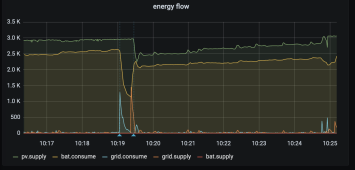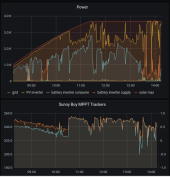The system is grid tie with two inverters - SMA Sunny Boy 3.6 and SMA Sunny Island 4.4. The problem is the Sunny Island ramp up speed when charging. If there is drop in the sun (short cloudy condition, i.e. 30 seconds) and then full sun the system does not get to full speed in matter of seconds, but in matter of minutes. In some cases this takes over 10 minutes.
Here is an example:

Green is the PV power produced by the Sunny Boy. Yellow is the battery charging power. The first vertical line at 10:19 is the moment when 2kW load was turned on. The second one that is 20 seconds later - when it was turned off. The PV power dip is obvious. It took about 5 minutes to ramp up the PV production to full speed.
How this is a problem - the family is at home full time. Me working from home + wife + 3 kids. These dips in the produced PV power are quite often. As result I'm loosing quite a few kWh each day and often the battery does not fully charge. An example is yesterday - sunny with no clouds, calculated max produced power is close to 28kWh, actual produced power is 20kWh and the battery was left at 80% in the evening. And it is a lot worse in the winters. Worst case scenario is when the oven is turned on. Once it reach the required temperature it switched between on and off cycles with 2.5kW load. This cripples the PV production severely. Not with 0.5kW like in the example above, but with close to 2kW for quite some time.
I suspect that this is caused by the huge grid supply spike when the load is removed. The system throttles the produced power and this impacts all systems. So I suspect that the cause is the algorithm in the SMA Home Manager 2.0 that is throttling the power production to avoid grid feedback.
Any ideas how this can be improved? Without switching from AC coupled to DC coupled system .
.
Note: The post was updated with more details and improved issue explanation. The old version was quite hard to understand.
Here is an example:

Green is the PV power produced by the Sunny Boy. Yellow is the battery charging power. The first vertical line at 10:19 is the moment when 2kW load was turned on. The second one that is 20 seconds later - when it was turned off. The PV power dip is obvious. It took about 5 minutes to ramp up the PV production to full speed.
How this is a problem - the family is at home full time. Me working from home + wife + 3 kids. These dips in the produced PV power are quite often. As result I'm loosing quite a few kWh each day and often the battery does not fully charge. An example is yesterday - sunny with no clouds, calculated max produced power is close to 28kWh, actual produced power is 20kWh and the battery was left at 80% in the evening. And it is a lot worse in the winters. Worst case scenario is when the oven is turned on. Once it reach the required temperature it switched between on and off cycles with 2.5kW load. This cripples the PV production severely. Not with 0.5kW like in the example above, but with close to 2kW for quite some time.
I suspect that this is caused by the huge grid supply spike when the load is removed. The system throttles the produced power and this impacts all systems. So I suspect that the cause is the algorithm in the SMA Home Manager 2.0 that is throttling the power production to avoid grid feedback.
Any ideas how this can be improved? Without switching from AC coupled to DC coupled system
Note: The post was updated with more details and improved issue explanation. The old version was quite hard to understand.
Last edited:




